 W
WThe Royal Canadian Mounted Police are the federal and national police service of Canada, providing law enforcement at the federal level. The RCMP also provide provincial policing in eight of Canada's provinces and local policing on a contract basis in the three territories and more than 150 municipalities, 600 Indigenous communities, and three international airports. The RCMP do not provide active provincial or municipal policing in Ontario or Quebec. However, all members of the RCMP have jurisdiction as a peace officer in all parts of Canada, not including Ontario and Quebec except for federal laws. Despite the name, the Royal Canadian Mounted Police are no longer primarily an actual mounted police service, with horses only being used at ceremonial events.
 W
WThe British Columbia Provincial Police (BCPP) was the provincial police service of British Columbia, Canada, between 1858 and 1950.
 W
WA buffalo coat is a heavy winter garment made from the bison, which also commonly known as the "buffalo". In North America they descended from the simpler, sleeveless buffalo robes worn by the Indigenous peoples of North America prior to their partial replacement by capotes made of point blankets during the North American fur trade. Similar garments were also used across Eurasia prior to the gradual displacement and near-extinction of the European bison or wisent. Commercially produced coats with sleeves and buttons became popular with non-indigenous people during the early settlement period of the American West and the Canadian prairies. Their use mostly ended because of a rising conservationist movement intended to preserve the bison, which had been hunted to near-extinction in North America as well.
 W
WA campaign hat, sometimes called campaign cover, is a broad-brimmed felt or straw hat, with a high crown, pinched symmetrically at the four corners.
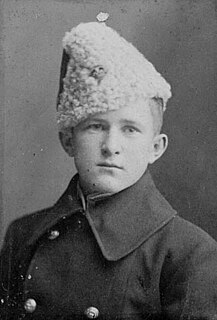 W
WThe Canadian military fur wedge cap, "envelope busby", or colloquially "The Astrakhan" is a uniform hat worn by the Canadian military and RCMP. The outside of the cap is entirely covered in real or synthetic fur and is shaped like a wedge. When not being worn the cap folds flat. The cap is about 8 inches (200 mm) high but is normally worn with the apex of the wedge shape depressed back into the interior of the cap to form a longitudinal trough at the crown, reducing the overall height. Often the cap is patterned such that the front of the crown will be slightly higher than the back. On one side of the military style fur wedge cap hangs a flat flap made of cloth or wool that extends from the crown to the bottom of the cap, known as the "bag". The colour of the "bag" was determined by the regimental colours. The bag is very similar to that worn with the busby. Because of the cap's passing resemblance to the hussar busby author and researcher James J. Boulton dubbed it the envelope busby. Still, whatever influence the busby may have had on its design, the fur wedge cap pattern was "distinctly Canadian."
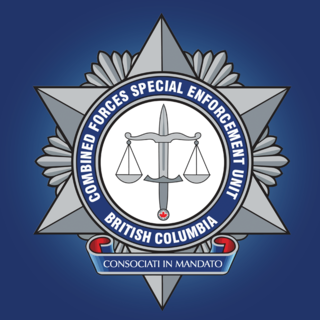 W
WThe Combined Forces Special Enforcement Unit – British Columbia (CFSEU-BC) was established in 2004 to facilitate the disruption and suppression of organized crime in BC and to support municipal police departments when public safety is deemed to be a priority. It is a part of the Royal Canadian Mounted Police (RCMP) "E" Division Federal Business Lines that is mandated to provide support and investigation into complex and diverse criminal activities in BC. It is modelled after other CFSEU units across the country and is currently staffed by RCMP officers and seconded officers from all 11 municipal police forces in British Columbia and Metro Vancouver Transit Police.
 W
WThe Royal Canadian Mounted Police (RCMP) has a history dating back to 1873 and has been involved in several high-profile controversies during that time, particularly in the 1970s.
 W
WCourage in Red is a 13-part television documentary that details many aspects of crime that the Royal Canadian Mounted Police must contend with on a daily basis. Each 30 minute episode focuses on a certain aspect of the RCMP such as training at the RCMP Academy, Depot Division in Regina, frontline police work, the Emergency Response Team, canine unit, and VIP protection among others.
 W
WThe Cypress Hills Massacre occurred on June 1, 1873, near Battle Creek in the Cypress Hills region of Canada's North-West Territories. It involved a group of American bison hunters, American wolf hunters or "wolfers", American and Canadian whisky traders, Métis cargo haulers or "freighters", and a camp of Assiniboine people. Thirteen or more Assiniboine warriors and one wolfer died in the conflict. The Cypress Hills Massacre prompted the Canadian government to accelerate the recruitment and deployment of the newly formed North-West Mounted Police.
 W
WOn October 14, 2007, Robert Dziekański —a Polish immigrant to Canada—was killed during an arrest at the Vancouver International Airport in Richmond, British Columbia.
 W
WThe Emergency Response Team (ERT) are police tactical units of the Royal Canadian Mounted Police based throughout Canada which are mainly part-time teams. According to the RCMP, the ERT "is a group of highly-trained RCMP members capable of employing specialized weapons, equipment, and tactics to resolve extremely high-risk situations." The ERT is also mandated to assess the situation and determine whether extreme danger or the presence of small arms cannot be easily resolved by RCMP officers on general duties or by other police forces throughout Canada. The ERT offers consulting services to its fellow officers such as firearms files and shootings that involve police officers.
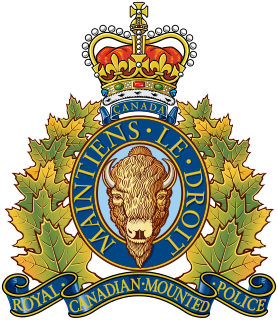 W
WCanadian Firearms Program, formerly Canada Firearms Centre is a Canadian government program within the Royal Canadian Mounted Police Policing Support Services, responsible for licensing and regulating firearms in Canada.
 W
WThe Highway of Tears is a 725-kilometre (450 mi) corridor of Highway 16 between Prince George and Prince Rupert, British Columbia, Canada, which has been the location of many Missing and murdered Indigenous women (MMIW) beginning in 1970. The phrase was coined during a vigil held in Terrace, British Columbia in 1998, by Florence Naziel, who was thinking of the victims' families crying over their loved ones. There is a disproportionately high number of Indigenous women on the list of victims. Proposed explanations for the years-long endurance of the crimes and the limited progress in identifying culprits include poverty, drug abuse, widespread domestic violence, disconnection with traditional culture and disruption of the family unit through the foster care system and Canadian Indian residential school system. Poverty in particular leads to low rates of car ownership and mobility; thus, hitchhiking is often the only way for many to travel vast distances to see family or go to work, school, or seek medical treatment. Another factor leading to abductions and murders is that the area is largely isolated and remote, with soft soil in many areas and carnivorous scavengers to carry away human remains; these factors precipitate violent attacks, as perpetrators feel a sense of impunity, privacy, and the ability to easily carry out their crimes and hide evidence.
 W
WIntegrated Security Unit (ISU) is a joint-services infrastructure security unit created to secure major events in Canada. This administrative and operational entity was first created by the Royal Canadian Mounted Police (RCMP) in 2003.
 W
W"Last Best West" was a phrase used to market the Canadian prairies to prospective immigrants. The phrase was used to advertise the Canadian west abroad, and in Eastern Canada, during the heyday of western settlement from 1896 until the start of the First World War in 1914, when few could leave Europe.
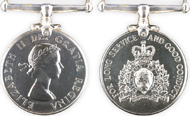 W
WThe Royal Canadian Mounted Police Long Service Medal was established by royal warrant on 6 March 1934 by King George V. It is the oldest continually awarded honour within the Canadian honours system, and the first created specifically for Canadian service within Canada. Initially proposed by the Royal Northwest Mounted Police Veterans’ Association, it took more than ten years for the proposal to be realized. The determination of the veterans was aided by the interest of Commissioner Cortlandt Starnes and Prime Minister R.B. Bennett.
 W
WThe Looting of Battleford began at the end of March, 1885, during the North-West Rebellion, in the town of Battleford, Saskatchewan, then a part of the Northwest Territories.
 W
WThe North-West Mounted Police (NWMP) made their initial journey to the Canadian prairies in March West, between July 8 and October 9 1874. The force was deployed to the Alberta border in response to the Cypress Hills Massacre and subsequent fears of a United States military intervention. Their ill-planned and arduous journey of nearly 900 miles (1,400 km) became known as the "March West" and was later portrayed by the force as an epic journey of endurance.
 W
WThe Martini–Henry is a breech-loading single-shot lever-actuated rifle that was used by the British Army. It first entered service in 1871, eventually replacing the Snider–Enfield, a muzzle-loader converted to the cartridge system. Martini–Henry variants were used throughout the British Empire for 47 years. It combined the dropping-block action first developed by Henry O. Peabody and improved by the Swiss designer Friedrich von Martini, combined with the polygonal rifling designed by Scotsman Alexander Henry.
 W
WThe Mayerthorpe tragedy occurred on March 3, 2005, on the farm of James Roszko, approximately 11 km (6.8 mi) north of Rochfort Bridge near the town of Mayerthorpe in the Canadian province of Alberta.
 W
WThe Moncton shootings were a string of shootings that took place on June 4, 2014, in Moncton, in the Canadian province of New Brunswick. Justin Bourque, a 24-year-old Moncton resident, shot five officers from the Royal Canadian Mounted Police (RCMP), killing three and severely injuring two. A manhunt for Bourque was launched and continued overnight and into June 5. On June 6, Bourque was found and taken into custody, ending a manhunt that lasted over 28 hours. The shooting was both Moncton's first homicide since 2010 and the deadliest attack on the RCMP since the Mayerthorpe tragedy in 2005, which left four RCMP officers dead. Bourque intended for the shootings to trigger a rebellion against the Canadian government.
 W
WThe North-West Mounted Police (NWMP) was a Canadian police force, established in 1873 by Prime Minister Sir John Macdonald, to maintain order in the North-West Territories. The mounted police combined military, police and judicial functions along similar lines to the Royal Irish Constabulary, and deployed the following year to the Alberta border in response to the Cypress Hills Massacre and subsequent fears of a United States military intervention. Their ill-planned and arduous journey of nearly 900 miles (1,400 km) became known as the March West and was portrayed by the force as an epic journey of endurance. Over the next few years, the police extended Canadian law across the region, establishing good working relationships with the First Nations. The force formed part of the military response to the North-West Rebellion in 1885, but faced criticism for their performance during the conflict.
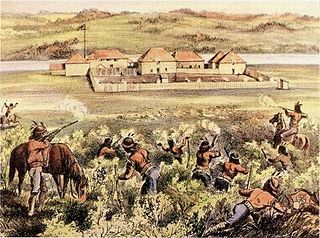 W
WThe North-West Mounted Police played a significant role during the North-West Rebellion in Canada in 1885. The North-West Mounted Police (NWMP) suffered early reverses and, although they supported the relief force sent to the region under the command of Major-General Frederick Middleton, their performance was heavily criticised. Commissioner Irvine resigned from his command of the police as a result.
 W
WThe Canadian North-West Mounted Police had a prominent role in popular media from the late 19th century onwards. The North-West Mounted Police (NWMP), founded in 1873, were initially viewed with scepticism by the press, but soon became portrayed in media and fictional accounts as courageous, disciplined and chivalrous, displaying a sense of fair-play as they brought their suspects to justice. In the 20th century, over 250 films were made about the force, along with radio and television portrayals.
 W
WThe history of the North-West Mounted Police in the Canadian north describes the activities of the North-West Mounted Police in the North-West Territories at the end of the 19th century and the start of the 20th. The mounted police had been established to control the prairies along the Canadian-United States border in 1873, but were then also deployed to control the Yukon region during the Klondike Gold Rush, and subsequently expanded their operations into the Hudson Bay area and the far north. The force was amalgamated in 1920 to form part of the new Royal Canadian Mounted Police, who continued their predecessors' work across the region.
 W
WThe October Crisis occurred in October 1970 in the province of Quebec in Canada, mainly in the Montreal metropolitan area. Members of the Front de libération du Québec (FLQ) kidnapped the provincial Deputy Premier Pierre Laporte and British diplomat James Cross. In response, Prime Minister Pierre Trudeau invoked the only peacetime use of the War Measures Act. The kidnappers murdered Laporte and negotiations led to Cross's release.
 W
WPleasant Camp, also known as the Dalton Trail Camp, is a historic frontier police outpost near Haines, Alaska. It was established by the Canadian Northwest Mounted Police in 1898 as a border station between the United States and Canada where they could control the flow of miners during the Klondike Gold Rush. It is located at Mile 40 of the Haines Highway. The post was operated by the NWP until roughly 1899. The border between the two countries was formalized in the area in 1900, resulting in the presence of this former Canadian outpost on US soil.
 W
WRCMP Academy, Depot Division has been providing police training to Royal Canadian Mounted Police (RCMP) "cadets" since its establishment in 1885. The facility is located in the west part of Regina, Saskatchewan, near the airport, and consists of several buildings.
 W
WThe Royal Canadian Mounted Police are the federal and national police service of Canada, providing law enforcement at the federal level. The RCMP also provide provincial policing in eight of Canada's provinces and local policing on a contract basis in the three territories and more than 150 municipalities, 600 Indigenous communities, and three international airports. The RCMP do not provide active provincial or municipal policing in Ontario or Quebec. However, all members of the RCMP have jurisdiction as a peace officer in all parts of Canada, not including Ontario and Quebec except for federal laws. Despite the name, the Royal Canadian Mounted Police are no longer primarily an actual mounted police service, with horses only being used at ceremonial events.
 W
W"E" Division is the division of the Royal Canadian Mounted Police in the province of British Columbia, Canada's westernmost province. It is the largest police body in the province, providing federal and provincial services throughout the province and policing all but 12 municipalities. In some urban areas, some municipalities have their own police forces while neighbouring ones contract with E Division. For example, Richmond is patrolled by E Division while neighbouring Vancouver has its own police force; both organizations contribute members and resources to various regional initiatives. E Division is the largest RCMP division, with 127 local detachments.
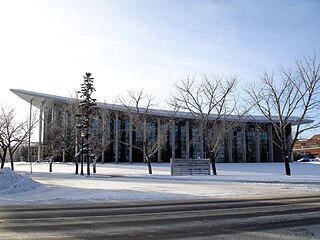 W
WThe RCMP Heritage Centre is a law enforcement museum located in Regina, Saskatchewan, Canada. The museum houses a number of exhibits on the Royal Canadian Mounted Police (RCMP) and artifacts relating to the police force. The heritage centre's 6,000-square-metre-building (65,000 sq ft) was designed by Nick Milkovich Architects, and is situated in the northeast end of RCMP Academy, Depot Division.
 W
WThe Red Coat Trail is a 1,300-kilometre (810 mi) route that approximates the path taken in 1874 by the North-West Mounted Police as they moved through the Canadian West.
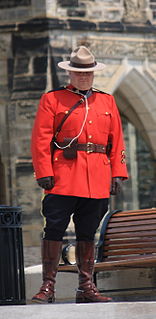 W
WThe Red Serge refers to the jacket of the dress uniform of the Royal Canadian Mounted Police. It consists of a scarlet British-style military pattern tunic, complete with a high-neck collar and blue breeches with yellow stripe identifying a cavalry history.
 W
WThe Red Wall: A Woman in the RCMP is a non-fiction book, written by Canadian writer Jane Hall, first published in July 2007 by General Store Publishing. In the book, the author chronicles her personal experiences as the first woman accepted in the Royal Canadian Mounted Police (RCMP). Hall recalls that ever since becoming a Mountie in 1977, people have asked her "What it was like"? Hall says she always avoided answering the question because she knew the story couldn't be told with a few sentences. The book's 351 pages are apparently sufficient as the book has been well received for its historical significance. Hall says of her book, "It was time to break the silence; time to acknowledge our successes and our failures. Time to move forward." Hall spent eight years writing her manuscript, and another two years copy-editing her work before presenting it for publication.
 W
WRough rider was a now defunct rank and appointment used in the British Army, and also in some British colonial forces, by men who were responsible for training horses and teaching equitation under the supervision of the riding master. If used as a rank it was equivalent to private, but non-commissioned officers could use it as an appointment, with designations such as troop sergeant major rough rider. Following its abolition as a rank, it continued to be used as an appointment.
 W
WThe RCMP Foundation was founded in 1994 as a charitable organization. Since 1994, the RCMP Foundation has contributed more than $10.5 million to support some 1,000 community groups initiatives across the country. "About Us".
 W
WThe Protective Policing Service is provided by the Royal Canadian Mounted Police. Its role is to provide security details for: 1) members of the Canadian Royal Family and the Governor General, 2) the Prime Minister, the families of the Prime Minister and Governor General, federal cabinet ministers, visiting VIPs, Members of Parliament and Senators, diplomats, Supreme, Federal Court and Federal Court of Appeal justices, and those designated by the Minister of Public Safety as protected persons.
 W
WRCMPV St. Roch is a Royal Canadian Mounted Police schooner, the first ship to completely circumnavigate North America, and the second vessel to transit the Northwest Passage. She was the first ship to complete the Northwest Passage in the direction west to east, going the same route that Amundsen on the sailing vessel Gjøa went east to west, 38 years earlier.
 W
WA slouch hat is a wide-brimmed felt or cloth hat most commonly worn as part of a military uniform, often, although not always, with a chinstrap. It has been worn by military personnel from many different nations including Australia, Ireland, Britain, India, New Zealand, Southern Rhodesia, France, the United States, the Confederate States, Germany and many others. Australia and New Zealand have had various models of slouch hat as standard issue headwear since the late Victorian period.
 W
WUnited States v Burns [2001] 1 S.C.R. 283, 2001 SCC 7, was a decision by the Supreme Court of Canada in which it was found that extradition of individuals to places where they may face the death penalty is a breach of fundamental justice under section 7 of the Canadian Charter of Rights and Freedoms. The decision reached this conclusion through a discussion of evidence regarding the arbitrary nature of execution, although the Court did not go so far as to say execution was also unconstitutional under section 12 of the Charter, which forbids cruel and unusual punishments.
 W
WWood Mountain is a village in the Canadian province of Saskatchewan within the Rural Municipality of Old Post No. 43 and Census Division No. 3. Its name is derived from the Red River Métis words "montagne de bois", due to the abundance of poplar trees in the otherwise barren region. Highway 18 and Highway 358 intersect south of the community.